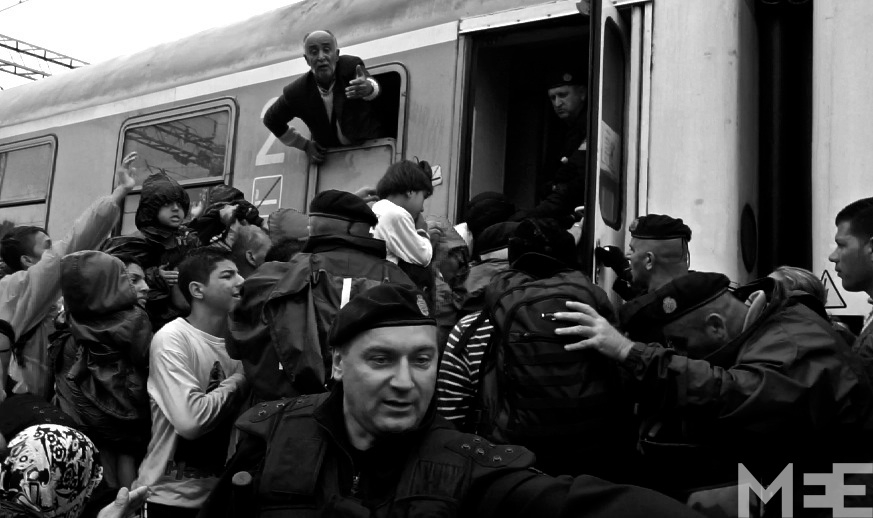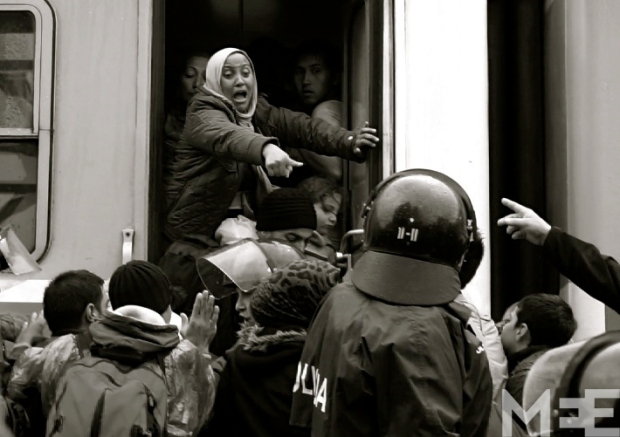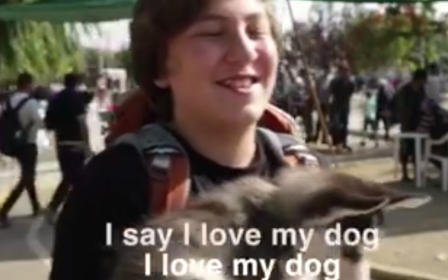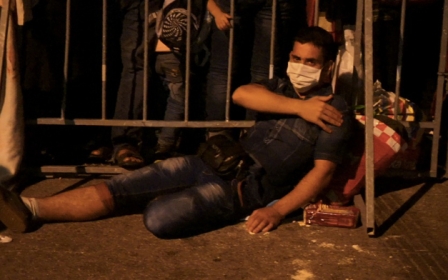Hungary and Croatia keep funnelling refugees north as crisis deepens

Crowded buses and trains, carrying thousands more refugees and migrants, flooded into Austria on Sunday from Croatia and Hungary, with tensions continuing to build on the Slovenia-Croatia border.
Austrian police said more than 11,000 entered the country on Saturday, while a further 4,700 arrived before midday on Sunday through the Nickelsdorf border post from Hungary.
Croatia meanwhile said that 25,000 refugees and migrants had entered the country in the past four days, with people continuing to enter from neighbouring Serbia. Chaotic scenes were reported on the border town of Tovarnik where some 2,000 people waited in the rain for trains to arrive to take them toward Zagreb and the border. Francesca Mannocchi, reporting from the scene for MEE said the situation was "hell".
Croatia has vowed to keep funnelling the refugees northeast to Hungary, with Interior Minister Ranko Ostojic saying that his plan was to keep transporting the vast majority of new arrivals to the border. However, sources told Croatian daily Vecernji List that if Hungary tried to close the border, the government would enact a plan C, which would see authorities send the refugees to the border in an uncontrolled manner, which would make it harder for the Hungarians to deal with the influx.
Hungary initially tried to stop people entering from Croatia, saying that it had put up barbed wire across sections of the border, but Budapest seemingly reversed course on Friday when it began providing transportation to the Austrian border in an apparent attempt to move the refugees from its boundaries as quickly as possible.
Early on Sunday, Hungary also reopened its main border crossing with Serbia, although it is as yet unclear if migrants and refugees will be allowed to cross and in what numbers.
Migrants and refugees have also tried to cross from Croatia into Slovenia to the north. The Slovenian authorities first tried to restrict entry and clashed with refugees and migrants but then began slowly allowing groups to cross and giving priority to those with children and medical conditions.
But as the numbers grew, one of the main border crossings was closed on Sunday, with Croatian media reporting that hundreds of people were now stuck at the Harmicu crossing.
The latest phase of the crisis began early on Tuesday when Hungarian authorities closed the Serbian border and enacted draconian anti-migrant laws that can see anyone entering the country illegally slapped with sentences of up to three years in jail and anyone found to be damaging the new border fence given up to five years.
The closure sent tens of thousands of people into neighbouring Croatia. While authorities said they were prepared for a few thousand people, they soon admitted to being overwhelmed by the sheer size of the influx.
President Kolinda Grabar-Kitarovic has now said that some 40,000 new refugees could come in the next few days, although this was disputed by Interior Minister Ostojic. There are currently believed to be some 15,000 refugees left in Serbia, although the numbers could be higher, with several thousand continuing to land in Greece almost daily.
Fresh tragedy in the Med
Fresh tragedy struck the coast off Greece on Sunday after at least 13 refugees and migrants died off when their inflatable dinghy carrying collided with a ferry, Turkish media reported.
Four children were among the dead, Dogan news agency reported.
Twenty people were rescued but 13 people are still missing, the report added. There was no information on the nationalities of the migrants.
The sinking was the second to rock the coast the Aegean Sea, with the Greek coastguard saying that another two dozen people were feared missing from a boat that got into trouble close to the Greek Island of Lesbos. Hundreds of people have already died this year, on their journey from Turkey to Europe, with many others drowning in the Mediterranean off the coast of Libya and Tunisia.
The vast majority of people are trying to reach places like Germany and Sweden that tend to have more generous asylum laws. Germany said that it expects up to one million asylum applications before the end of the year.
The influx has put immense pressure on the Schengen system that guarantees open borders between most member states. Greece, Slovenia, Hungary, as well as the richer northern states are all members but fellow EU member Croatia is not. While Serbia has applied for EU membership, it has yet to be accepted as a member.
The continent's biggest migratory flow since the end of World War II has widened rifts between western and eastern EU members over how to distribute the new arrivals.
Fresh EU talks, aimed at finding a solution to the crisis, are slated to take place on Tuesday but some states, namely Poland and Hungary, remain opposed to any plans to forcibly relocate refugees within their borders. Previous plans put forward by EU chief Jean-Claude Juncker to relocate 160,000 people came to nothing after failing to win approval.
EU Enlargement Commissioner Johannes Hahn has now said that Europe is looking to pledge "up to one billion euros" ($1.13bn) worth of aid to try to encourage Syrian refugees in Turkey to stay there. Austria and Germany also issued a joint call for UN countries to contribute an extra five billion euros ($5.6bn) to help refugees living in camps in Lebanon and Jordan.
Of the more than four million Syrians who have fled the conflict, nearly half are now in Turkey, while more than a million are living in Lebanon and at least 600,000 in Jordan.
New MEE newsletter: Jerusalem Dispatch
Sign up to get the latest insights and analysis on Israel-Palestine, alongside Turkey Unpacked and other MEE newsletters
Middle East Eye delivers independent and unrivalled coverage and analysis of the Middle East, North Africa and beyond. To learn more about republishing this content and the associated fees, please fill out this form. More about MEE can be found here.





